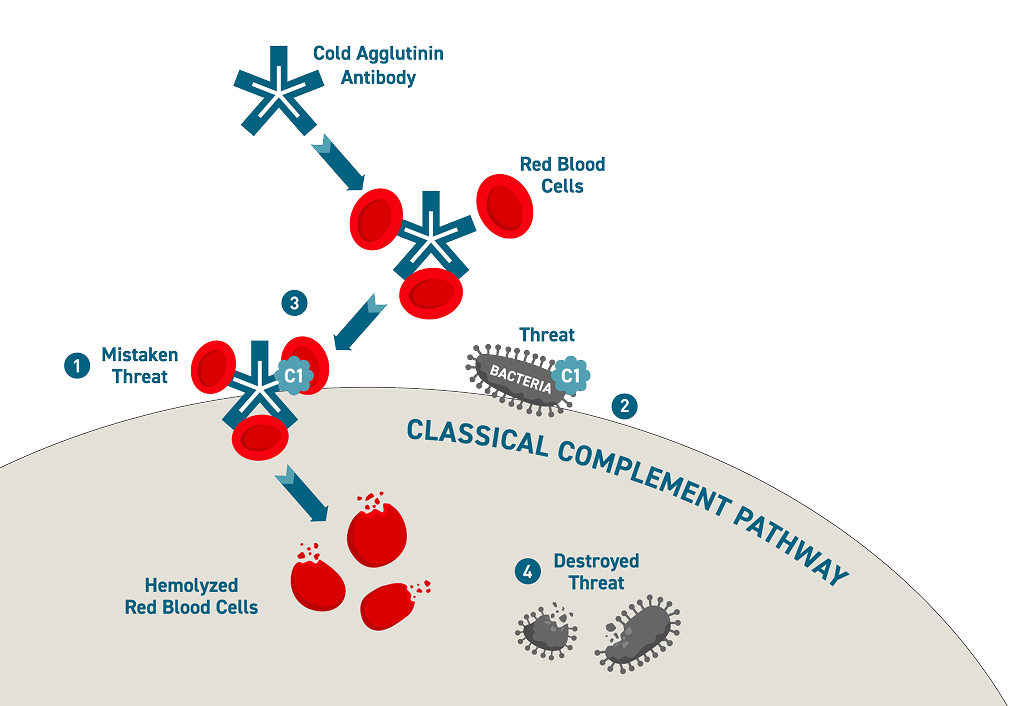


Patient Solutions (1-833-223-2428)



ABOUT
CAD
What is Cold Agglutinin Disease?
Understanding Cold Agglutinin Disease (CAD)
Learning about how Cold Agglutinin Disease affects your body and how to recognize common symptoms may help you and your healthcare provider better manage your Cold Agglutinin Disease.
Cold Agglutinin Disease is a form of complement-dependent autoimmune hemolytic anemia, in which a part of the immune system known as the complement system mistakenly attacks and destroys red blood cells in a process called hemolysis. Cold Agglutinin Disease can affect people as young as 30, but usually affects people 50 to 70 years of age.
When people look at you they can’t tell that anything is wrong. Maybe they think you’re tired or lazy, or just getting older, but that is not the case.
—NANCY, LIVING WITH COLD AGGLUTININ DISEASE (CAD)


How does hemolysis happen?

- In Cold Agglutinin Disease, the body makes cold agglutinin antibodies that mistakenly identify your own red blood cells as a threat
- When the cold agglutinin antibodies encounter red blood cells, they attach to the surface, causing them to clump together (called agglutination)
- When the red blood cells are bound to the cold agglutinin antibodies, they form a complex that signals for the activation of the classical complement pathway through a protein called C1
- For those who do not have Cold Agglutinin Disease, C1 is activated when antibodies bind to foreign threats, like bacteria
- The C1 binds to the surface of the red blood cells and starts a chain of events that ends with the destruction of the red blood cells, or hemolysis


Symptoms of Cold Agglutinin Disease can press pause on your life
When the rate of hemolysis, or red blood cell destruction, is faster than the rate at which the body makes new red blood cells, the result is low levels of red blood cells (anemia).
Symptoms caused by complement activation:
Symptoms caused by the cold:


What causes symptoms of Cold Agglutinin Disease?
Red blood cells are vital for carrying oxygen and carbon dioxide to and from your organs and tissues. For example, your muscles need them to move, and your brain needs them to function.
With fewer red blood cells moving around your body due to hemolysis, less oxygen is delivered to your organs and tissues.
This can make you feel tired and without enough energy to do the things you want to do. It can also make you feel weak, short of breath, or even make thinking or concentrating difficult.




What can your blood tell you about your health?
One way your doctor can keep an eye on your health is by looking at the different components of your blood. Below is some information on commonly used terms and various blood tests your doctor may request. He or she may perform all of these tests or just a few depending on your needs.
HEMOGLOBIN
Usually found inside red blood cells, this protein helps to transport oxygen and carbon dioxide throughout the body
RETICULOCYTES
Young (immature) red blood cells that are produced to replace red blood cells that have been destroyed
BILIRUBIN
A pigment that is released when hemoglobin is broken down
ANTIBODY TITER
Measures the concentration and strength of antibodies (such as cold agglutinins) in your blood
LACTATE DEHYDROGENASE (LDH OR LD)
An enzyme that is released when cells are destroyed
MEAN CORPUSCULAR VOLUME (MCV)
A measure of the average size and volume of red blood cells in your blood
HAPTOGLOBIN
A protein in the blood whose job it is to find hemoglobin that has been released from destroyed red blood cells and flag it for recycling
BLOOD SMEAR
Evaluates the shape, size, color, and arrangement of red blood cells and also looks at your white blood cells and platelets


Have any questions?
Find the answers to the most frequently asked questions about Cold Agglutinin Disease (CAD) and how to treat it.

What is ENJAYMO?
ENJAYMO® is a prescription medicine used to treat the breakdown of red blood cells (hemolysis) in adults with cold agglutinin disease (CAD).
It is not known if ENJAYMO is safe and effective in children.
IMPORTANT SAFETY INFORMATION
Do not receive ENJAYMO if you are allergic to sutimlimab-jome or any of the ingredients in ENJAYMO.
ENJAYMO can cause serious side effects, including:
- Serious Infections: ENJAYMO is a prescription medicine that affects your immune system. ENJAYMO may lower the ability of your immune system to fight infections. ENJAYMO increases your chance of getting serious infections including those caused by encapsulated bacteria, including Neisseria meningitidis, Streptococcus pneumoniae, and Haemophilus influenzae type B. These serious infections may quickly become life-threatening or cause death if not recognized and treated early.
- You must complete or be up to date with the vaccines against Streptococcus pneumoniae and Neisseria meningitidis at least 2 weeks before your first dose of ENJAYMO.
- If your healthcare provider decides that urgent treatment with ENJAYMO is needed, you should receive vaccinations as soon as possible.
- If you have been vaccinated against these bacteria in the past, you might need additional vaccines before starting ENJAYMO. Your healthcare provider will decide if you need additional vaccines.
- Vaccines do not prevent all infections caused by encapsulated bacteria. Call your healthcare provider or get emergency medical care right away if you get any of these signs and symptoms of a serious infection: fever with or without shivers or chills, fever with chest pain and cough, fever with high heart rate, headache and fever, confusion, clammy skin, fever and a rash, fever with breathlessness or fast breathing, headache with nausea or vomiting, headache with stiff neck or stiff back, body aches with flu-like symptoms, and/or eyes sensitive to light.
- Infusion-related reactions: Treatment with ENJAYMO may cause infusion-related reactions, including allergic reactions that may be serious or life-threatening. Your healthcare provider may slow down or stop your ENJAYMO infusion if you have an infusion-related reaction and will treat your symptoms if needed. Tell your healthcare provider right away if you develop symptoms during your ENJAYMO infusion that may mean you are having an infusion-related reaction, including: shortness of breath, decrease in blood pressure, chest discomfort, rapid heartbeat, nausea, injection site reaction, flushing, headache, dizziness, rash, and itchy skin.
- Risk of autoimmune disease: ENJAYMO may increase your risk for developing an autoimmune disease such as systemic lupus erythematosus (SLE). Tell your healthcare provider and get medical help if you develop any symptoms of SLE, including: joint pain or swelling, rash on the cheeks and nose, and unexplained fever.
- If you have CAD and you stop receiving ENJAYMO, your healthcare provider should monitor you closely for return of your symptoms after you stop ENJAYMO. Stopping ENJAYMO may cause the breakdown of your red blood cells due to CAD to return. Symptoms or problems that can happen due to red blood cell breakdown include: tiredness, shortness of breath, rapid heart rate, and blood in your urine or dark urine.
The most common side effects of ENJAYMO include: increase in blood pressure, urinary tract infection, respiratory tract infection, bacterial infection, swelling in lower legs or hands, joint pain, headache, nausea, runny nose, bluish color to the lips and skin, dizziness, feeling tired or weak, cough, and changes in color or sensation in the fingers and toes (Raynaud’s phenomenon).
These are not all the possible side effects of ENJAYMO. Call your doctor for medical advice about side effects. You are encouraged to report side effects of prescription drugs to the FDA. Call 1-800-FDA-1088 or visit www.fda.gov/medwatch.
Before receiving ENJAYMO, tell your healthcare provider about all of your medical conditions, including if you: have a fever or infection, including a history of human immunodeficiency virus (HIV), hepatitis B, or hepatitis C; have an autoimmune disease such as systemic lupus erythematosus, also known as lupus; are pregnant or plan to become pregnant. It is not known if ENJAYMO will harm your unborn baby; are breastfeeding or plan to breastfeed. It is not known if ENJAYMO passes into your breast milk.
Tell your healthcare provider about all the medicines you take, including prescription and over-the-counter medicines, vitamins, and herbal supplements.
